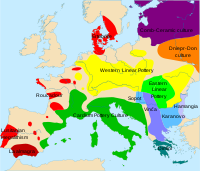
Photo from wikipedia
Laser ablation-inductively coupled plasma-mass spectrometry (LA-ICP-MS) is an increasingly popular direct solid sampling micro-analytical technique for multi-element analysis in provenance studies of archaeological pottery. However, the development and use of… Click to show full abstract
Laser ablation-inductively coupled plasma-mass spectrometry (LA-ICP-MS) is an increasingly popular direct solid sampling micro-analytical technique for multi-element analysis in provenance studies of archaeological pottery. However, the development and use of a reliable quantification strategy for the analysis of pottery clay via ns-LA-ICP-MS is not self-evident due to the lack of commercially available matrix-matched clay reference materials covering a wide range of characterized element concentrations. In this work, the capabilities and limitations of various calibration approaches were evaluated, based on the analysis of NIST SRM 679 Brick Clay as a model sample. Calibration relied on the use of either (i) 5 glass reference materials or (ii) the matrix-matched reference material New Ohio Red Clay (NORC) as external calibration standard(s). Four calibration strategies were compared and it was shown that (a) external calibration without internal standard correction is not suitable when using glass reference materials for calibration, but can be used in the case of calibration against a clay reference material, (b) different sum normalization approaches produce results that are very similar to each other and (c) glass reference materials used as standards in an external calibration approach with internal standard correction or a sum normalization method can provide accurate results for a wide range of major, minor and trace elements. Finally, the utility of an appropriate sum normalization calibration approach was illustrated by analysis of 10 sediments relevant to provenance studies of Final Mesolithic and Early Neolithic pottery in the Scheldt valley and their successful discrimination employing linear discriminant analysis (LDA) based on 44 element concentrations. The use of polished sediment thin sections in combination with transmitted light microscopy enabled the clay fraction of the sediments only to be meticulously sampled. A dedicated outlier rejection protocol was applied to minimize the contribution of non-visible constituents.
Journal Title: Journal of Analytical Atomic Spectrometry
Year Published: 2020
Link to full text (if available)
Share on Social Media: Sign Up to like & get
recommendations!